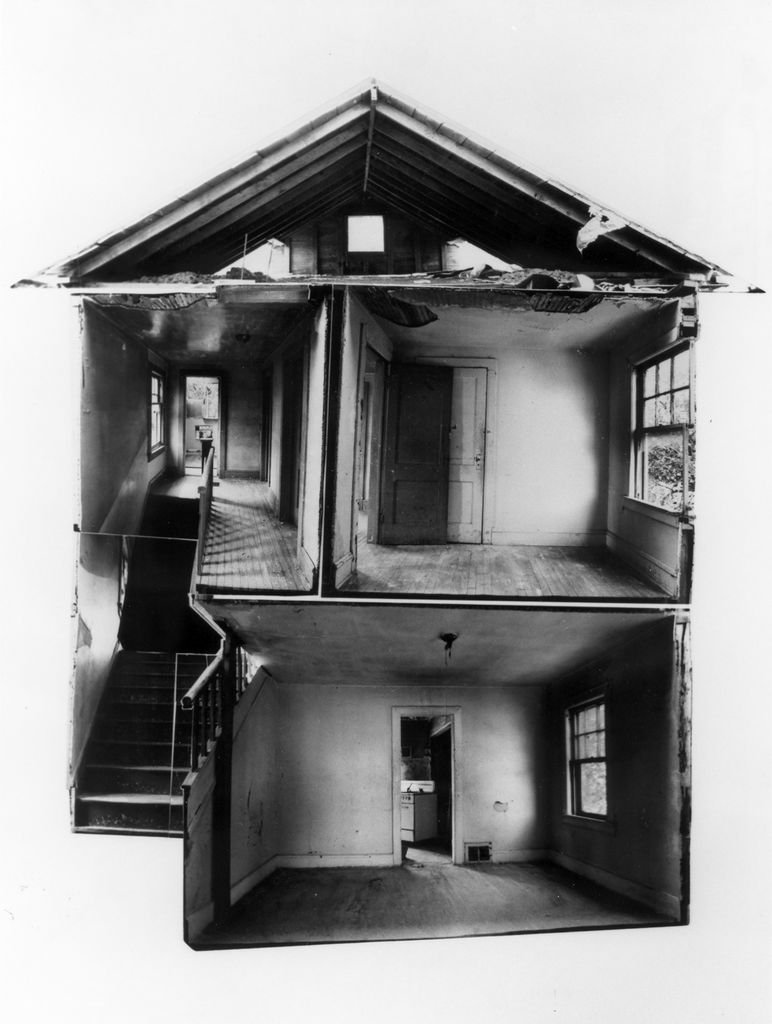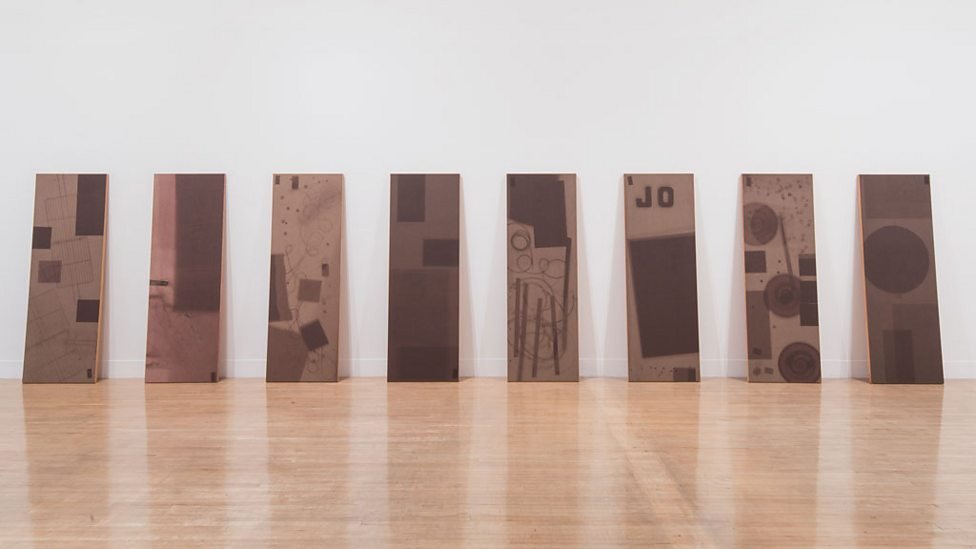Module Toolbox: Weeks 3&4
(This blog post was initially intended for publishing in June 2022)
I’ve been busy this topic making work. I really want to use this module as an opportunity to play and experiment with my photographic practice as much as possible and the Toolbox of strategies has helped me greatly towards this.
I think the fact that I have this new space to play in and the associated sense of discovery and transition that comes with making a new home is really fuelling my drive and opening up the possibilities for the methods I can use to explore my interest in home-making.
The first experiments I have been making are rephotographs. I am using photographs from the first day of owning the house and placing them in the spaces as they are now after several weeks of renovation and modernisation. The original photographs were intended as a personal record of the details of the house in its original state, before the impact of our desires and intensions became evident. I wanted to capture the personality of the space; a reflection of the previous owner. Religious artefacts, decorative details and oddities were observed and documented.
The resulting rephotographs display the temporal shift usually associated with this method. However, the time span between each image is not as significant as the rearrangement of space documented in the more recent images. I want these photographs to portray a space in transition, time ongoing, rather than a before and after juxtaposition.
Moving forward, I don’t feel that this is a method which I will continue with for my main research practice. I might return to these once the spaces are transformed a little more and again when they are somewhat complete. However, as playful as these are I see them as too literal and illustrative. I would like to capture time in this work in more subtle and nuanced ways.
The rephotographs make me thing of Barthes’ Spectrum of the Photograph (1981:9). I see the idea of the spectrum as being not quite the ‘thing’, more of a whisper or trace. These photographs show the apparition of the past, floating mid air, ghost-like. Indeed as Barthes sees the ‘return of the dead’ (1981:9) in every photograph so too do these combinations summon that which is past; lost even.
Finnegan 2022. Digital Rephotography.
For this method I made two sets of images to the same end. In the first I placed one photograph in the other digitally. This approach meant that I could manipulate the image to place it more accurately in the pictorial plane. I could also manipulate the contrast between each image so that there was enough of a difference that the placed image stood out. For me the ones that work best are those where the placed image is larger in the frame and where lines and other details correlate closely.
Finnegan 2022. Renovation Rephotography
The second series seems to work better in my opinion. Here I held printed photographs in situ. Unlike those above, it was hard to line up detail due to the fixed size of the prints. I found I improvised much more, placing the prints where they it felt right rather than where they should go. The physically printed photographs and inclusion of my hand creates more noticeable spatial sense. These are photographs of things, as a thing in a space. As a result I feel that the elements combine to create a more coherent photographic image than the previous attempt.
Again I am drawn to my recent reading of Barthes in understanding how these work. The original photographs here show their ‘referent’ (1981:5); in this case details of the house. In rephotographing these as photographic objects, they become the referent. So the resulting rephotographs refer to the act of photographing photographs as objects as well the original referent. Barthes argued that ‘a photograph cannot be transformed’ (1981:5) but I feel that the act of rephotographing bypasses this in a significant way.
Finnegan 2022. Work in progress.
Finnegan 2022. Work in progress.
Responding to the idea of Force in the Toolbox I attempted to use Photoshop’s automated photomerge feature to create an impossible perspective of the interior of the house. This was partly informed by Gordon Matta Clark’s photo-collage Splitting 32 (1975) with the original intention being to build a composite from panoramic photographs of every room in the house.
For the downstairs space I wanted to stitch together 9 images, taken at 3 locations across the space. In forcing the software to stitch these disparate perspectives together I have realised that some programs cannot be overcome. Photoshop just wouldn’t do it so I had to fall back on combining 3 separate panorama’s.
However, having made these I noticed irregularities where the areas of each image overlapped. Shifts in perspective, repeated objects and widening or narrowing of doorways occurred. I made several versions and observed variations in these errors across all iterations. This got me excited as I was handing over control to the machine and allowing an algorithm to decide the form of the work.
I presume that by using a wide angle lens for these images the distortion caused by the lens as it pans the space is what confuses the software to create these exciting discrepancies. This made me think about how easily we trust programs and automated processes to enhance our photography but how in reality the images these computational images (Dewdney 2022) result in are far from real.
Matta Clark 1975. Splitting 32. [photo-collage]
Finnegan 2022. Work in progress.
I began exploring these panoramic realities by cropping in to places where these irregularities occurred. It’s interesting that the reconfiguring of floorboards or doorframes almost goes unnoticed even in these close-ups. With closer attention however, there is still an uncanniness to these scenes. I feel they work much better that the original panoramas as there is a more pronounced sense of something being not quite right.
Finnegan 2022. Work in progress.
Finnegan 2022. Work in progress.
Finnegan 2022. Work in progress.
One could even trust in the geometries of these spaces, believing them to be part of a modern design. The image above looks fairly natural until we notice the horizontal perspective of the doorway which leads the eye to a the edge of the door that tapers to an almost impossible thinness. I like the idea of creating impossible or theoretical spaces, and see a link here between the imagined home and the reality of a living working domestic space.
Matta Clark 1974. Splitting. [photo-collage]
A similar loss of physical geometry and conventional perspective is also evident in Matta Clark’s collage above. Here the sense of space as well as our orientation inside that space is thrown into confusion. I would like to push the method I’ve explored here to force more dynamic and visually exciting distortions. The idea of making the home more un-homely through this process could be something to play with.
Finnegan 2022. Pinterest combinations
Following my reading of The System of Objects (Baudrillard 1996) I had the idea of using advertising images of homes (kitchens in this case). Rather than using printed material I found images on Pinterest as I use this to find ideas for home decorations, furniture and home improvements. I see the existence of Pinterest as being wholly in line with Baudrillard’s insistence of ‘man the interior designer’ and an effective tool for one who programs rather than inhabits their spaces (1996:26).
Instead of consuming objects, he dominates, controls and orders them. He discovers himself in the manipulation and tactical equilibration of a system.
(Baudrillard 1996:27)
The resulting images show a range of discrete and not-so-discrete irregularities of scale and perspective. These are exciting for me as again they are subtle enough to make the viewer look twice; revealing themselves slowly. I think it’s important for the ‘trick’ to not be too apparent. Also by appropriating images I have bypassed the need to take similar photographs and can use the professional, stylised forms of these already appealing photographs. I would like to continue this method and I’d like to release them back onto Pinterest.
Finnegan 2022. Work in progress.
These photographs, although not necessarily inspired by the Toolbox, reference back to my previous experiments making sculpture within the house using found material and ephemera from the renovation process. Here I removed pieces of wall that were intended for disposal and brought them to my studio at home. These block-like pieces of render, plaster and paint can be arranged like building blocks or children’s toys. Markings on some pieces are traces of marks made for communicating where to place plug sockets and switches. They are visual reminders of conversations between the tradesmen and myself. I think these photographs work well and I can see that my use of lighting is improving. I will develop this skill further through the workshops at the F2F. These do sit at odds with some of the work above but I’m trying not to worry too much about coherency at this point in the module.
Amaut and Meyer 2014. Montessori Stab [framed pigment print]
For this work I was inspired by the work of Amaut and Meyer. Their practice obsessively documents objects and artefacts from a range of fields including art history, mathematics and science. They are concerned with how things are and I enjoy the ontological nature of their method. Their use of colour and background is something I will explore further in this strand of my methodology.
Finnegan 2022. Documentation of lumen print process.
Finnegan 2022. Lumen prints.
My final batch of experiments this topics use the lumen print to create photograms of debris from around the site. For many of these sun-exposed images the exposure time was relative to the length of time it took me to do a specific task or job. I wasn’t too worried about over-exposing and knew that as experiments it was fine for them not to work. I’m using old emulsion paper that has long past it’s use-by but find that for these types of photos this has no impact. I haven’t fixed them as I’m interested in them as ephemeral traces. They are hidden away in a large book. I hope that over time the images will disappear and fade, much like the memories of this time or how the current form of the house will be replaced by the next. This again brings Barthes’ spectra to mind, as a whisper or trace of something, not quite it but close.
There’s also sustainability concerns here where I am using out of date materials and avoiding buying photochemicals. I could use a salt fix but I like the idea of sending these images into the future and possibly towards their erasure.
Finnegan 2022. Digital layering and manipulation of lumen prints.
Pryde 2016. Title unknown. [sun-bleached paper on wood]
These photograms were made using the paper underside of kitchen counters. I’ve observed this effect recently on cardboard and other materials in the home. I would like to experiment with using materials from the build to make sun-exposed images.
Finnegan 2022. Lumen prints.
Finnegan 2022. Work in progress.
References and reading:
BARTHES, Roland. 1981. Camera Lucida: Reflections on Photography. 1st American ed. New York: Hill and Wang.
BAUDRILLARD, Jean. 1996. The System of Objects. London ; New York: Verso.
DEWDNEY, Andrew. 2022. Online book launch & talk: Andrew Dewdney & Joanna Zylinska - Forget Photography. London, The Photographers’ Gallery, 16th February 2022. [online]
































